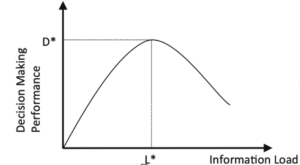Blogpost written by Cem Baykalli and Chidiebere Uhegbu
Key Takeaways
- Information overload is a big challenge in computer science, marketing, management, logistics, and accounting.
- The 6 steps of the decision-making process are starting situations, information sources, information search and processing, subjective information stance, decision-making and choice, behavior and emotions after the decision.
- Studies on information overload are fast rising, specifically in emerging domains such as social media and online collaboration.
Information Overload and why is it important?
Is information overload costing the global economy $650 billion annually? This staggering statistic by Lohr (2007) underscores the profound impact of information overload on productivity and well-being in today’s workplace.With the rise of information technology, storing and categorizing the data is easier and reaching data from various sources leads users to suffer processing, evaluating and reacting a myriad of information on a daily basis.
According to Wikipedia, Information overload (also known as information anxiety) is the difficulty in understanding an issue and effectively making decisions when one has too much information (TMI) about that issue. It is generally associated with the excessive quantity of daily information.
Information Overload occurs when users are faced with too much information than their capacity to collect, understand and evaluate based on their own judgment.This overload specifically kills productivity and can increase stress level,anxiety even burnout.This blog summarizes, key points on relate to Information Overload from Roetzel 2019 article for better understanding.
Decision-making,personal prejudgments and bounded rationality
The status quo reveals that while research on information overload peaked in the 1980s and 1990s interest waned in the early 2000s. However, the invention of digital technologies and the internet has reignited attention in university research, particularly focusing on social media and virtual collaboration.
We, the users of new technologies, are quite limited to process information compared to Machine Learning algorithms like AI or Chat GPT. Human brain usually has a tendency to leave more information out than its capacity to understand. In addition to the amount, the level of complexity is another factor that causes the human brain to hit the burnout. The quote “a wealth of information creates a poverty of attention”” describe the situation as the mathematical function in fig1. As the formula refers, after over the threshold, information load does not have a positive effect on making a final decision. The independent variable is the capacity of processing the information that defines the threshold value.

Fig. 1 Information and decision-making performance
Decision-making process as Roetzel 2019 stated has 6 steps to discover from all perspectives.Among them,the triangle relationship between how individuals search the information, their personal prejudices about information collected and processing the information –evaluation, editing, and weighting of information- plays a vital role in the final decision.
Trust or reputation of the information sources and the ease of using the information are effects the way information sources are selected. As you can see these characteristics of information sources are directly bound to personal perceptions. Selection of resources is quite important because it is the fundamental step to decide.
Personal prejudgments to categorize information is the way to evaluate a piece of information whether it is relevant or valuable. This is helpful for them to devote their time and attention to only useful and relevant information. If we apply the fig1 on the selecting of alternatives, once individuals reach their capacity they stop gathering additional information and decide finally on their bounded rationality. The term means that as people try to make good decisions, they often do so within the limits of what they can know and understand.
Current and Future Trends, Conclusion
Information overload is one of the side effects of decision-making in the digital era. Once digitization leads information digital, to process the heaps of information requires more cognitive effort. In order to overcome it, we unintentionally take a sample from huge resources based on our personal traits and beliefs and shape our decision. Each step of decision-making is bound to our personal biases or prejudgments.Even though catching up the pace of technology in terms of information processing is hard, the technology or how it is designed are not primary suspects of Information Overload on their own.
From our perspective, with the rise of the reliance on AI technologies changes the game and not the information but also decisions can be categorized by it as well in near future. Just as categorizing the information, decisions could be categorized and for less important ones can be appointed to AI. Even though the expectations are higher right now, we believe that AI will be centered around modern lifestyle.